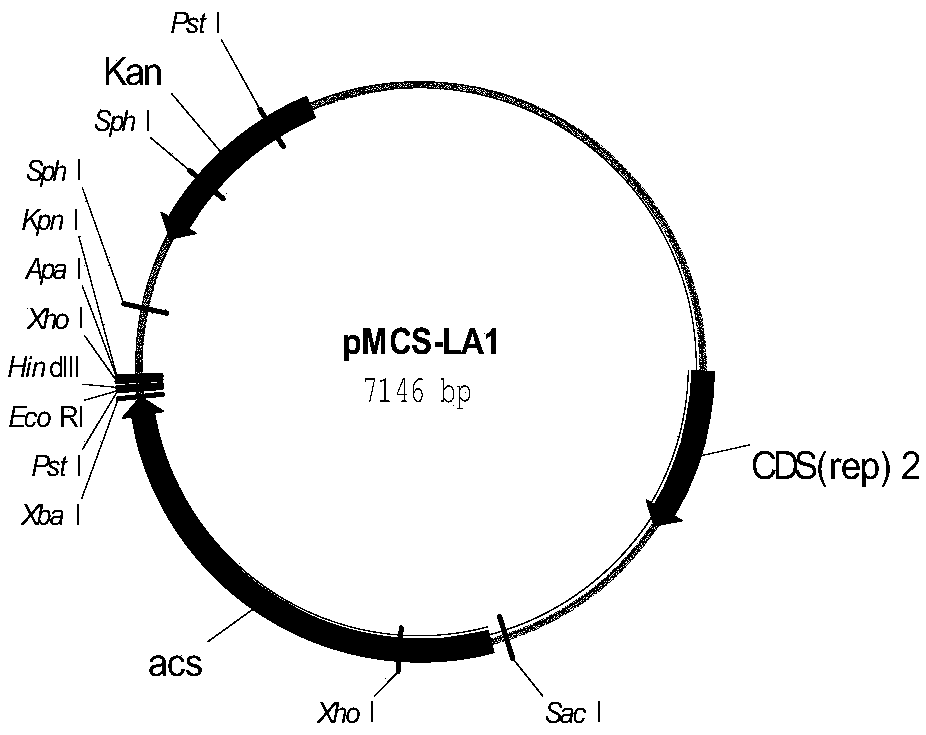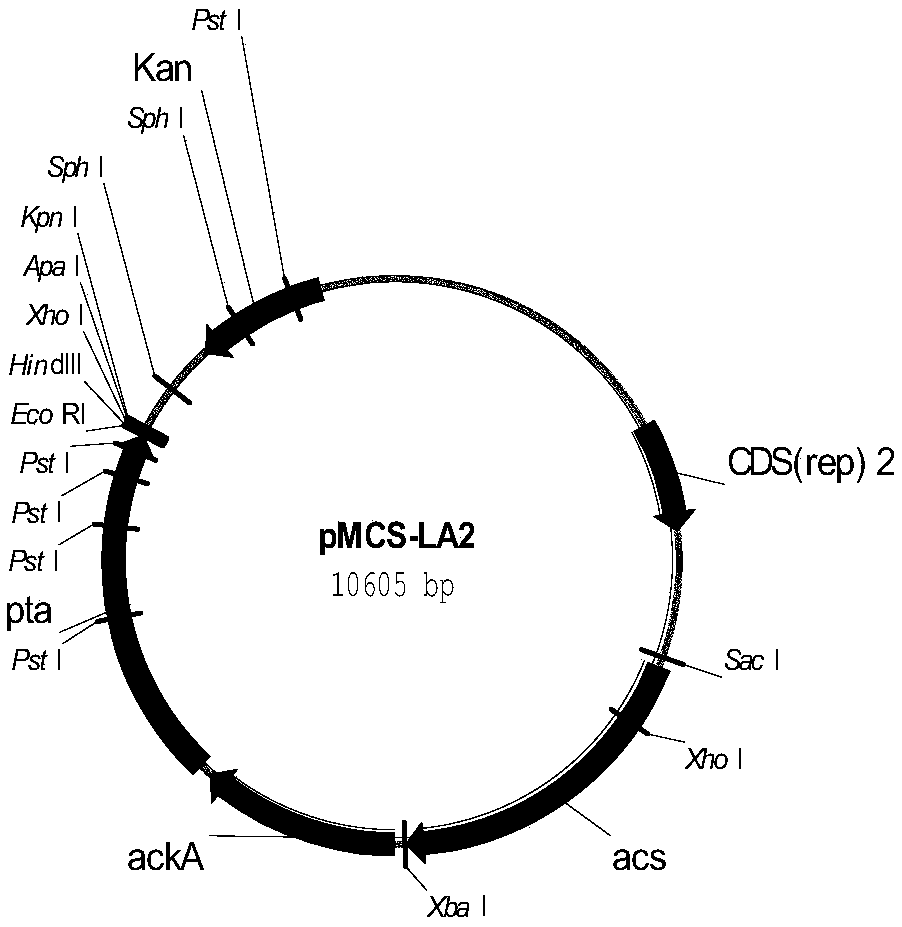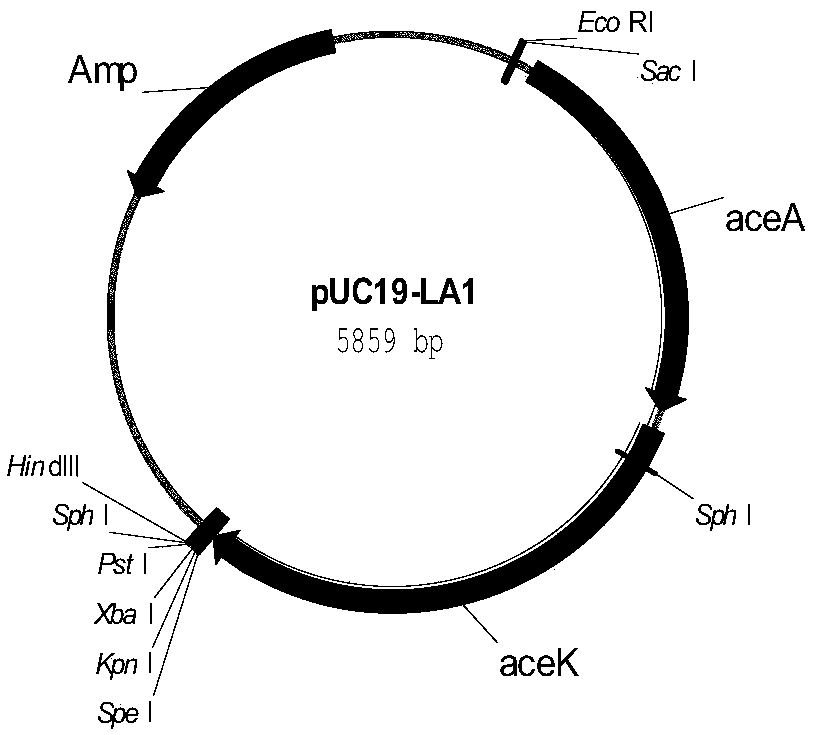Genetic engineering bacteria for producing L-lactic acid from acetic acid, construction method thereof and application thereof
A construction method, gene technology, applied in the field of genetic engineering, fermentation engineering, and biotechnology, can solve the problems of restricting wide application and high market price of L-lactic acid
- Summary
- Abstract
- Description
- Claims
- Application Information
AI Technical Summary
Problems solved by technology
Method used
Image
Examples
Embodiment 1
[0146] Example 1. Construction of recombinant bacteria E.coli LA5 (pMCS-LA2+pUC19-LA4)
[0147] 1. Construction of recombinant expression vectors pMCS2-LA1 and pMCS2-LA2
[0148] 1. The artificially synthesized DNA shown in Sequence 1 in the sequence list contains the acs expression cassette, the upstream is the SacI site, and the downstream is the XbaI site, wherein the 9th-51st nucleotide is the promoter sequence, and the 70th-2028th nucleotide Nucleotides are acs gene sequences.
[0149] 2. The artificially synthesized DNA shown in Sequence 2 in the sequence list contains ackA and pta expression cassettes, the upstream is the XbaI site, and the downstream is the EcoRI site, wherein the 9th-51st nucleotides are the promoter sequence, and the 70th- Nucleotide 1272 is the ackA gene sequence, and 1347-3491 nucleotides are the pta gene sequence.
[0150]3. Use SacI and XbaI to double digest the DNA sequence synthesized in sequence 1, and recover a DNA fragment with a size of a...
Embodiment 2
[0233] Embodiment 2, the application of recombinant bacteria E.coli LA5 (pMCS-LA2+pUC19-LA4) in the production of L-lactic acid
[0234] 1. Shake flask culture experiment of recombinant bacteria E.coli LA5 (pMCS-LA2+pUC19-LA4)
[0235] 1. Cultivate the E.coli LA5 (pMCS-LA2+pUC19-LA4) prepared in step 7 of Example 1 in LB liquid medium containing ampicillin and kanamycin at 37°C and 200rpm for 16h , as a seed solution.
[0236] 2. Inoculate the seed liquid into the MM liquid medium containing ampicillin and kanamycin according to the inoculation amount of 4% by volume, and the liquid amount in a 250 ml shake flask is 50 ml, and cultivate under the condition of 37 ° C and 100 rpm At 24h, the fermentation broth was collected at 12h and 24h of cultivation, respectively.
[0237] 3. Quantitative detection of L-lactic acid produced by genetically engineered bacteria and acetic acid consumed by high performance liquid chromatography. The specific conditions are as follows:
[023...
PUM
 Login to View More
Login to View More Abstract
Description
Claims
Application Information
 Login to View More
Login to View More - R&D
- Intellectual Property
- Life Sciences
- Materials
- Tech Scout
- Unparalleled Data Quality
- Higher Quality Content
- 60% Fewer Hallucinations
Browse by: Latest US Patents, China's latest patents, Technical Efficacy Thesaurus, Application Domain, Technology Topic, Popular Technical Reports.
© 2025 PatSnap. All rights reserved.Legal|Privacy policy|Modern Slavery Act Transparency Statement|Sitemap|About US| Contact US: help@patsnap.com



